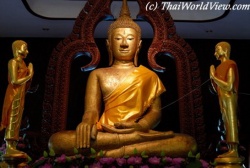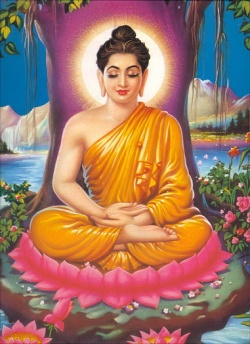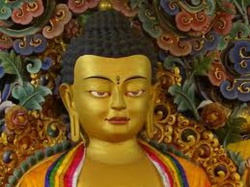Cause and Effect and the Nine Consciousnesses
Cause and Effect
As we go about our daily lives, in every single moment, we make causes in the things that we think, say and do. Buddhism teaches the existence of a law of cause and effect, which explains that when we make a cause, the anticipated effect of that cause is
stored deep in our lives, and when the right circumstances appear then we experience the effect. This concept of cause and effect is at the heart of Buddhism, and the characters for 'renge' in Nam-myoho-renge-kyo mean the simultaneity of the internal cause and the internal effect. This means that, through chanting, we have made the cause for our Buddhahood, and the effect of it exists simultaneously with that cause. By chanting we are directly causing our Buddhahood to appear.
'Renge' literally means 'lotus flower', which is a beautiful plant that floats on the surface of water and its beauty is nourished through its roots in the mud. This is a metaphor for our lives. Chanting Nam-myoho-renge-kyo uses the `mud` in our lives to enable us to reveal our highest life-state.
But the Lotus flower is significant for a second reason. It is a plant that flowers and seeds at the same time. It beautifully illustrates the profound working of life where the effect is simultaneous with the cause.
An example of the way Buddhism views cause and effect might be of a young person going home to spend a weekend with their parents. They have a blazing row before the end of the weekend and the young person leaves. In Western society we tend to see the blazing row as the cause and the young person leaving the effect. But Buddhism focuses attention on the internal [[cause
and effect]]. So it may be that the internal cause turns out to be that the young person disrespects their parents, at quite a deep level, perhaps without realizing it. The effect, which is simultaneous with this cause is the state of hell, and it is this that is triggering the arguing. This example could equally be the other way round, with the parents doing the disrespecting. It is the internal cause and effect, which a person who chants Nam-myoho-renge-kyo can change, replacing their internal feelings with respect.
Through the simultaneity of cause and effect we can cause our Buddhahood to appear. To help us gain a clearer understanding of what Nam-myoho-renge-kyo is we need to appreciate the nine consciousnesses. The nine consciousnesses can be thought of as different layers of consciousness, which are constantly operating together to create our lives. And as we progress through explanations of these consciousnesses the significance of the principle of the simultaneity of cause and effect should become apparent.
The Nine Consciousnesses
These are:-
1. Touch
2. Taste
3. Sight
4. Hearing
5. Smell
6. Conscious Mind
7. Subconscious/Limited Egoistic Self
8. Karma store
9. Buddha nature/Nam-myoho-renge-kyo
The first five 'consciousnesses' are our basic senses of sight, hearing, touch, smell and taste, which we use to take in information from outside ourselves in order to understand what is going on in the world. Imagine the moment of birth. The baby at that moment is aware of sound, of smell, touch, taste and sight. Like the baby we become attached to the world to such a degree that, for many, the world in all its complexities continues to hold our attention and we remain ignorant of the working of the deeper 'layers' of consciousness.
Eventually the baby grows and learns that what it is seeing is, say, 'blue' or what it is feeling is 'hot'. This is the sixth consciousness or the mind as we are used to thinking of it, which functions to enable us to make sense of what is coming to us through our senses. It is primarily through the interaction of these first 6 consciousnesses that we perform our daily activities.
The seventh consciousness is directed towards our inner, spiritual world. It is in the 7th consciousness that the conditioning we experience as we grow up is stored. It is through this consciousness that we have our sense of who we are, our gender, our national identity and so on. Attachment to a self distinct and separate from others has its basis in this consciousness as does our sense of right and wrong. We might see the appearance of various therapies and counselling in the West as a response to the desire on the part of many to free themselves from some of the conditioning that has taken place in life and which is stored in the 7th consciousness.
Western culture really only has an understanding of the first 7 consciousnesses. The concept of an eighth consciousness storing all our internal causes and internal effects (our karma) is generally not in use in daily life. And the concept of a ninth consciousness being the fundamental workings of life itself throughout the universe is definitely not part of our culture! The ninth consciousness in Buddhism is Nam-myoho-renge-kyo or the Law of life
The eighth and ninth consciousnesses are operating at the level of the fundamental interconnectedness of all of life. If our eyes could see our karma and the 9th consciousness we would see all of life as deeply interconnected. The perception created in the 7th consciousness of a fixed and isolated self is thus false. This is one of the deep seated delusions regarding the nature of the self. The narrow ego of the 7th consciousness resists life expansion. A human life which is 'touching' the eighth consciousness is cracking the shell of the limited ego and becoming open to its greater self. The seventh consciousness is also the seat of the fear of death. Locked in the 7th consciousness the narrow ego assumes it will perish and cease to exist at death. Such a life is unable to see that the eighth consciousness is an enduring flow of life energy that will migrate between lifetimes.
The delusion that the 7th consciousness is one's true self is fundamental ignorance, a turning away from the interconnectedness of all beings. It is this sense of oneself as separate that gives rise to discrimination, destructive arrogance, and the acquisition of material possessions and wealth that far surpass what any one human being could possibly need.
The eighth consciousness is a vast storehouse of all the causes and effects, which affect the way that the world comes to us. It is where we accumulate our karma, both positive and negative. It accounts for our looks, our circumstances, our reactions, our good or bad fortune, our work, our relationships, our health, in fact, every aspect of living. As causes are made in thought or word or deed, so internal effects are stored in this level of consciousness.
Because the internal cause and effect exists deep inside, on a level of life, which is interconnecting with all of life, eventually external causes and effects appear in response to the karma in the eighth consciousness. It is the existence of the eighth consciousness that explains the great differences which exist between say 'identical' twins in their experiences of life. It explains how things that happen to a young child appear to have no cause in this lifetime. It is this eighth consciousness or karma, which migrates between lifetimes. It is our karma from previous lifetimes which we are born with, which then causes the world to come to us on the basis of our internal causes in all the different aspects of life.
If life were only these eight consciousnesses things would be fatalistic and bleak. One cause would create its effect, which would condition all future causes and their effects and so on, leaving us stuck on a particular path with particular tendencies. We cannot gain access to this 8th karmic consciousness with our minds, which are too shallow. Will-power and effort alone will not enable us to change deep-seated karmic tendencies.
The Ninth Consciousness
Buddhism teaches that there is a ninth consciousness, which Nichiren Daishonin identified as the Buddha nature, or Nam-myoho-renge-kyo. It is the basis of all life's functions and is known as the 'amala' or 'fundamentally pure' consciousness, shared at the most profound level with all life. As we chant Nam-myoho-renge-kyo, so life-force comes from the ninth consciousness, purifying the internal causes and effects that lie in the eighth, and improving the way our sixth and seventh consciousnesses function. We start to create new causes in the eighth consciousness, based not on the tendencies that we have developed after making many different causes, but on the life-state of the Buddha, and therefore filled with courage, compassion and wisdom. Another benefit of this process is that we start to see our lives with the eyes of the Buddha, enabling us to see our karma in its true light. As we see it, so it becomes easier to challenge it and change it.
To use an analogy, the emergence of the world of Buddhahood is like the rising of the sun. When the sun dawns in the east, the stars that had shone so vividly in the night sky immediately fade into seeming non-existence. If they disappeared, it would go against the principle of causality. But just as the light of the stars and the moon seems to vanish when the sun rises, when we bring forth the state of Buddhahood in our lives we cease to suffer negative effects for each individual past negative cause made. In other words, this does not deny or contradict general causality. General causality remains an underlying premise of Buddhism. But it is subsumed by what might be termed a 'greater causality'. This greater causality is the causality of attaining Buddhahood. It is the causality of the Lotus Sutra and the Mystic Law.
Chanting Nam-myoho-renge-kyo then liberates us from our negative or unhappy karma, and enables us to make causes and create lives that accord with our greatest dreams both for ourselves and for the society in which we live. The best causes we can make are those that contribute to kosen-rufu, and help people to establish Nam-myoho-renge-kyo in their own lives, enabling them to reveal their own Buddha nature.




